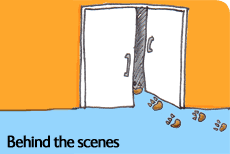What's in a name? A history of taxonomy
By Sandra Knapp
Cladistics and collections

Willi Hennig (1913-76). Image #337083, American Museum of Natural History Library
Science involves a great deal of expertise. For a long time ideas about the relationships that were believed to exist between groups of plants and animals, that had been long-established by the scientific authorities of the day, were rarely challenged. Whoever was the expert had the last word. In the first decades of the twentieth century, a new generation of taxonomists started to question the accepted dogma, and suggest alternatives.
Testing hypotheses
In the 1930s a German entomologist named Willi Hennig started developing an entirely new way of looking at relationships. His work was to change the way taxonomists work and still influences the way research is done today. Hennig proposed the practice of taxonomy as a series of tests of hypotheses. For example, three hypotheses could be applied to a group of three species, say the coelacanth, the lungfish, and a salamander:
- Hypothesis One, the coelacanth and the lungfish are more closely related to each other than either is to the salamander.
- Hypothesis Two, the salamander and the lungfish are more closely related to each other than either is to the coelacanth.
- Hypothesis Three, the coelacanth and the salamander are more closely related to each other than either is to the lungfish.
A taxonomist would call this a three-taxon statement--the simplest set of hypotheses possible. To uphold or falsify the hypotheses, the taxonomist would amass evidence in support of or against them by looking at the organisms' characteristics--a term shortened to 'characters'.
The characters are each assigned a number. If say, character number one is present in all three species under study, A, B and C, while character two is present in species A and B and absent in species C; the taxonomist can define a group of A+B based on the distribution of character two. Character distribution can be mapped for all the species being studied, and this distribution can reveal groupings of species that are more closely related to each other than to anything else under study. Species and characters can be added to the study, and this method makes taxonomy--the relationship determining part of it--repeatable and shows others how the researcher arrived at their conclusions about taxonomy.
This methodology allows taxonomists to identify two types of groups of species. One type includes all the descendants of a common ancestor and is known as a monophyletic group. The other type, known as a paraphyletic group, includes most, but not all of the descendants of a common ancestor. A third type of group is the polyphyletic group, where the members do not share a common ancestor. With Hennig's developments, the task of taxonomy became to identify the monophyletic groups by defining species' characters unambiguously and plotting their distribution.
Cladistics
This new way of doing taxonomy was called cladistics. The word cladistics comes from clade, itself derived from the Greek word for branch. A clade is a group of organisms that share characters, and by extension, a common ancestor. Clades are monophyletic groups. Cladistics meant that scientists no longer relied on the gospel according to scientific authority. Now they were able to look at groups of organisms, study their characters and suggest alternative hypotheses.
In this way, an alternative hypothesis regarding the position of green algae in relation to other plants was suggested. Green algae were always considered to be a discrete and coherent group, all closely related to each other and relatively distantly related to land plants. But analysis of the distribution of certain characters such as type of cell division and microtubule organization revealed that the green algae are an artificial, paraphyletic, group. Despite superficial similarities, some members of the group are much more closely related to land plants than they are to other green algae.
Cladistics challenged the method of doing taxonomy that had been accepted without question for a very long time. In the 1960's when Hennig's book Phylogenetic Systematics (it was published in 1950 in German as Grundzüge einer Theorie der Phylogenetischen Systematik) was first translated into English and came into British and American academic circles, it was extremely controversial. But now, cladistics is widely accepted and through its application, much of the order of the natural world has been revealed. It was cladistic analysis that lead to the discovery that birds and dinosaurs are more closely related to each other than either is to reptiles. Cladistic ideas have become firmly established in all kinds thinking about plants and animals, and the way their relationships are depicted.
Collecting and collections
The most important elements of taxonomy are the specimens themselves, many held in museums and collections around the world. As well as relying on collections, taxonomists often go out into the field to find new organisms and collect specimens, and to see plants and animals in their native habitats. When plants are collected they are pressed in newspaper and dried--in the same way as traditional flower pressing. They are then mounted on paper so that they can be studied. Plant specimens from high up in trees are often collected with pole clippers, similar to those used by tree surgeons. They have several extension sections and are extremely efficient, but heavy to carry around. In some parts of the world, scientists hire local people to climb trees for them to access specimens. In other parts of the world, where the locals don't do this, the scientists sometimes learn to do it themselves.

Emptying collected insects from a Malaise trap jar. (Image: Alex Monro)
Entomologists sometimes collect insects in much the same way as their predecessors did, using butterfly nets with very long poles. They now also use a wide variety of mechanical methods of trapping insects, ranging from simple pitfall traps to more complex light traps and even more complicated methods. The Malaise trap consists of a netting frame that goes all the way to the ground. Insects fly into the netting, and in an attempt to escape they go upwards to find themselves in the peak of the tent. They are naturally attracted to the daylight from the pale top of the tent but on approaching it, drop into a bottle of alcohol. Workers often leave this sort of trap in a remote area for up to a week, and in this way collect a wide diversity of insects, including those which would never be trapped using a butterfly net. The jar of alcohol and insects--a sort of insect 'sludge'--is then sorted to major groups, and specimens are prepared in the usual way, by pinning. Some of the specimens collected in this way are so tiny they need to be glued to a tiny cardboard triangle through which the pin is inserted.
Specimens are prepared in much the same way that they always have been. Butterflies and moths are pinned through the body and put into special spreading boards, then their wings are spread flat out on boards, and then they are dried at extremely low heat in an oven. Using this method the wings stay flat and spread so the colour pattern can be clearly seen.
Toolbox

Our scientists study the snails that host the schistosomiasis parasite, which causes a disease that affects nearly 200 million people.
